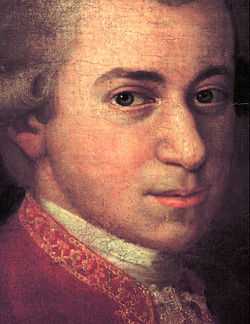Piano Concerto No. 10 (Mozart)
It is not known when Mozart completed this concerto for two pianos in E-flat major, K. 365/316a, but research by Alan Tyson shows that cadenzas for the first and third movements are written in his and his father's handwriting on a type of paper used between August 1775 and January 1777. It is presumed that Mozart wrote it to play with his sister Maria Anna (“Nannerl”). Years later he performed it in a private concert with pupil Josepha Barbara von Auernhammer.
The concerto was originally scored for the two pianos together with two oboes, two bassoons; two horns; and strings. Mozart later expanded the score with pairs of clarinets, trumpets and timpani in E flat and B flat. The piece is in three movements:
- Allegro common time
- Andante B-flat major 3/4
- Rondo: Allegro 2/4
The concerto departs from the usual solo piano concerto with the dialogue between the two pianos as they exchange musical ideas. Mozart divides up the more striking passages quite evenly between the two pianos. Also, the orchestra is rather more quiet than in Mozart's other piano concertos, leaving much of the music to the soloists.
The first movement is lyrical and "wonderfully spacious, as if Mozart is thoroughly enjoying himself and letting his ideas flow freely," as Ledbetter has noted. The middle movement is slow and refined; the orchestra stays in the background behind the pair of playful pianists. The finale is a rondo filled with rhythmic drive and, after passages of lyrical grace, there is an exuberant return to the main rondo theme.
External links
- Concerto in E-flat for two pianos KV 365 (316a): Score and critical report (German) in the Neue Mozart-Ausgabe
- Program notes by Steven Ledbetter for the performance of November 12, 2006 by the Los Angeles Chamber Orchestra
- Piano Concerto No. 10: Scores at the International Music Score Library Project
| ||||||||||||||||||||
